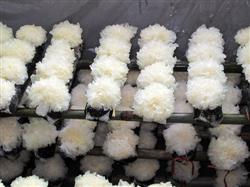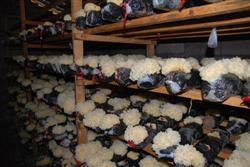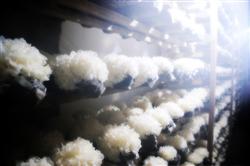What are the requirements for the growing environment of Tremella fuciformis?

What are the requirements for the growing environment of Tremella fuciformis? Tremella fuciformis can not do photosynthesis like plants, use chlorophyll to make its own nutrients, but rely on organic matter in other organisms as its nourishment, absorb ready-made carbohydrates, nitrogenous substances and small amounts of minerals. All kinds of substitute medium is a nutritious place for the growth of Tremella fuciformis. In addition, in the process of growth, there are certain requirements for nutrition temperature, air relative humidity, air (oxygen) illumination and pH. Therefore, in the process of cultivation, various measures must be taken to meet the growth and development characteristics of Tremella fuciformis and meet its requirements in order to achieve the goal of stable and high yield. 1. Nutrition is the material basis for the growth of Tremella fuciformis, and the synthetic ratio of substitute medium should meet all kinds of nutrition requirements of Tremella fuciformis to the maximum extent. Tremella mycelium can directly use simple carbohydrates such as monosaccharides (glucose) and disaccharides (sucrose). Because the ability of Tremella fuciformis mycelium to decompose lignin and cellulose is very low, cellulose and lignin can not be used directly, only ash mycelium decompose lignin and cellulose under the action of enzyme. Tremella mycelium can be used. The culture material should also have sufficient mineral elements such as nitrogen, vitamins, phosphorus, calcium and trace elements to facilitate the growth of fruiting bodies. 2. Humidity water is the first condition for the life activity of Tremella fuciformis, and Tremella fuciformis requires more than one water. That is, spores germinate into hyphae under humid conditions (relative humidity 70%-80%), and hyphae are also colonized and spread under humid conditions. And differentiate and produce fruiting body primordia at a certain stage of development. The fruiting body develops rapidly in a humid environment (relative humidity is 80%-90%), displaying ear slices of fat, tender, jade bone ice muscle. Under the condition of excessive humidity, it is not easy to germinate into hyphae, but in the form of budding. Only under suitable wet conditions can the mycelium colonize and grow exuberantly. The hyphae were thick and short into bundles and the fruiting bodies differentiated normally. In the over-wet environment, the growth of hyphae is weak, thin and sparse, and the fruiting bodies are poorly differentiated or gelatinized into clusters. Therefore, appropriate moisture should be given according to the different humidity requirements of different stages of Tremella growth. 3. Temperature and temperature is an important factor for the life activity and growth rate of Tremella fuciformis. Tremella fuciformis is a mesophilic fungus. The hyphae (including Tremella fuciformis and ash hyphae) can grow within 16 ℃ ~ 30 ℃, of which 20 ℃ ~ 28 ℃ grows normally, 23 ℃ ~ 25 ℃ grows best, and the hyphae below 20 ℃ or above 28 ℃ are delicate. The temperature of fruiting body differentiation was between 16 ℃ and 28 ℃, growth retardation below 16 ℃ and poor differentiation above 28 ℃. The optimum temperature should be 22 ℃ ~ 25 ℃. Tremella fuciformis has strong cold resistance, and the spores will not lose their germination power at 0 ℃ for 2 hours. 4. Air (oxygen) Tremella is a kind of aerobic fungus. The need for oxygen for mycelium germination increases with the increase of mycelium quantity. The need for oxygen in the differentiation of fruiting bodies should also be mastered, with large ears and small ears. In the environment of suitable temperature and humidity, the oxygen is sufficient and the fruit body differentiates rapidly. in the case of hypoxia, the mycelium grows slowly and the fruit body differentiation is slow, so it is necessary to ventilate properly in the process of cultivation. 5. Direct light with strong light, which is disadvantageous to the mycelium germination and fruiting body differentiation of Tremella fuciformis. Scattered light can promote spore germination and fruiting body differentiation. Different light has a significant effect on the color of Tremella fuciformis fruit body, dark light yellow fruit body differentiation is slow, appropriate scattered light, ear white matter is excellent. 6. Acidity and alkalinity (PH value) Tremella fuciformis is a weakly acidic fungus, the PH value should be between 5.2 and 5.8, excessive acid or alkali have a certain effect on Tremella fuciformis. None of the above factors exist in isolation and management must be strengthened. Try to meet the growth requirements of Tremella fuciformis, so as to achieve high yield and high quality. Click to get more cultivation techniques of Tremella fuciformis
- Prev

With what method is Tremella fuciformis cultivated?
With what method is Tremella fuciformis cultivated? Please introduce the cultivation methods of Tremella fuciformis as follows: first, the culture medium used for Tremella cultivation is: cotton seed shell 50 kg, wheat bran 10 kg, gypsum powder 0.5 kg, white sugar 0.5 kg, magnesium sulfate (98%) 0.25 kg. Potassium dihydrogen phosphate (98% agricultural.
- Next

How to cultivate Tremella fuciformis?
How to cultivate Tremella fuciformis? What are the cultivation methods? Tremella fuciformis is a kind of advanced tonic, which has the functions of strengthening essence, tonifying kidney, moistening lung, promoting body metabolism, skin tenderness and body fitness. Growth conditions Tremella fuciformis needs a certain temperature, humidity, light, air, acid and alkali.
Related
- Fuxing push coffee new agricultural production and marketing class: lack of small-scale processing plants
- Jujube rice field leisure farm deep ploughing Yilan for five years to create a space for organic food and play
- Nongyu Farm-A trial of organic papaya for brave women with advanced technology
- Four points for attention in the prevention and control of diseases and insect pests of edible fungi
- How to add nutrient solution to Edible Fungi
- Is there any good way to control edible fungus mites?
- Open Inoculation Technology of Edible Fungi
- Is there any clever way to use fertilizer for edible fungus in winter?
- What agents are used to kill the pathogens of edible fungi in the mushroom shed?
- Rapid drying of Edible Fungi

